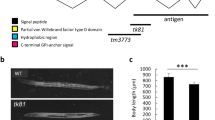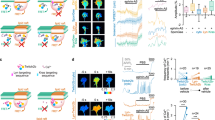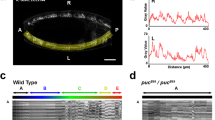Abstract
UNC-6/Netrin and its receptor UNC-40/DCC are conserved regulators of growth cone guidance. By directly observing developing neurons in vivo, we show that UNC-6 and UNC-40 also function during axon formation to initiate, maintain and orient asymmetric neuronal growth. The immature HSN neuron of Caenorhabditis elegans breaks spherical symmetry to extend a leading edge toward ventral UNC-6. In unc-6 and unc-40 mutants, leading edge formation fails, the cell remains symmetrical until late in development and the axon that eventually forms is misguided. Thus netrin has two activities: one that breaks neuronal symmetry and one that guides the future axon. As the axon forms, UNC-6, UNC-40 and the lipid modulators AGE-1/phosphoinositide 3-kinase (PI3K) and DAF-18/PTEN drive the actin-regulatory pleckstrin homology (PH) domain protein MIG-10/lamellipodin ventrally in HSN to promote asymmetric growth. The coupling of a directional netrin cue to sustained asymmetric growth via PI3K signaling is reminiscent of polarization in chemotaxing cells.
This is a preview of subscription content, access via your institution
Access options
Subscribe to this journal
Receive 12 print issues and online access
$209.00 per year
only $17.42 per issue
Buy this article
- Purchase on Springer Link
- Instant access to full article PDF
Prices may be subject to local taxes which are calculated during checkout






Similar content being viewed by others
References
Dotti, C.G., Sullivan, C.A. & Banker, G.A. The establishment of polarity by hippocampal neurons in culture. J. Neurosci. 8, 1454–1468 (1988).
Inagaki, N. et al. CRMP-2 induces axons in cultured hippocampal neurons. Nat. Neurosci. 4, 781–782 (2001).
Shi, S.H., Cheng, T., Jan, L.Y. & Jan, Y.N. APC and GSK-3β are involved in mPar3 targeting to the nascent axon and establishment of neuronal polarity. Curr. Biol. 14, 2025–2032 (2004).
Kishi, M., Pan, Y.A., Crump, J.G. & Sanes, J.R. Mammalian SAD kinases are required for neuronal polarization. Science 307, 929–932 (2005).
Shi, S.H., Jan, L.Y. & Jan, Y.N. Hippocampal neuronal polarity specified by spatially localized mPar3/mPar6 and PI 3-kinase activity. Cell 112, 63–75 (2003).
Menager, C., Arimura, N., Fukata, Y. & Kaibuchi, K. PIP3 is involved in neuronal polarization and axon formation. J. Neurochem. 89, 109–118 (2004).
da Silva, J.S. & Dotti, C.G. Breaking the neuronal sphere: regulation of the actin cytoskeleton in neuritogenesis. Nat. Rev. Neurosci. 3, 694–704 (2002).
Goldberg, J.L. et al. Retinal ganglion cells do not extend axons by default: promotion by neurotrophic signaling and electrical activity. Neuron 33, 689–702 (2002).
Lefcort, F. & Bentley, D. Organization of cytoskeletal elements and organelles preceding growth cone emergence from an identified neuron in situ. J. Cell Biol. 108, 1737–1749 (1989).
Halfter, W., Deiss, S. & Schwarz, U. The formation of the axonal pattern in the embryonic avian retina. J. Comp. Neurol. 232, 466–480 (1985).
Weiner, O.D. Regulation of cell polarity during eukaryotic chemotaxis: the chemotactic compass. Curr. Opin. Cell Biol. 14, 196–202 (2002).
Van Haastert, P.J. & Devreotes, P.N. Chemotaxis: signalling the way forward. Nat. Rev. Mol. Cell Biol. 5, 626–634 (2004).
Weiner, O.D. et al. A PtdInsP(3)- and Rho GTPase-mediated positive feedback loop regulates neutrophil polarity. Nat. Cell Biol. 4, 509–513 (2002).
Hedgecock, E.M., Culotti, J.G. & Hall, D.H. The unc-5, unc-6, and unc-40 genes guide circumferential migrations of pioneer axons and mesodermal cells on the epidermis in C. elegans. Neuron 4, 61–85 (1990).
Wadsworth, W.G., Bhatt, H. & Hedgecock, E.M. Neuroglia and pioneer neurons express UNC-6 to provide global and local netrin cues for guiding migrations in C. elegans. Neuron 16, 35–46 (1996).
Serafini, T. et al. The netrins define a family of axon outgrowth-promoting proteins homologous to C. elegans UNC-6. Cell 78, 409–424 (1994).
Hong, K. et al. A ligand-gated association between cytoplasmic domains of UNC5 and DCC family receptors converts netrin-induced growth cone attraction to repulsion. Cell 97, 927–941 (1999).
Chan, S.S. et al. UNC-40, a C. elegans homolog of DCC (Deleted in Colorectal Cancer), is required in motile cells responding to UNC-6 netrin cues. Cell 87, 187–195 (1996).
Keino-Masu, K. et al. Deleted in Colorectal Cancer (DCC) encodes a netrin receptor. Cell 87, 175–185 (1996).
Hamelin, M., Zhou, Y., Su, M.W., Scott, I.M. & Culotti, J.G. Expression of the UNC-5 guidance receptor in the touch neurons of C. elegans steers their axons dorsally. Nature 364, 327–330 (1993).
Desai, C., Garriga, G., McIntire, S.L. & Horvitz, H.R. A genetic pathway for the development of the Caenorhabditis elegans HSN motor neurons. Nature 336, 638–646 (1988).
Garriga, G., Desai, C. & Horvitz, H.R. Cell interactions control the direction of outgrowth, branching and fasciculation of the HSN axons of Caenorhabditis elegans. Development 117, 1071–1087 (1993).
Knobel, K.M., Jorgensen, E.M. & Bastiani, M.J. Growth cones stall and collapse during axon outgrowth in Caenorhabditis elegans. Development 126, 4489–4498 (1999).
Krause, M., Dent, E.W., Bear, J.E., Loureiro, J.J. & Gertler, F.B. Ena/VASP proteins: regulators of the actin cytoskeleton and cell migration. Annu. Rev. Cell Dev. Biol. 19, 541–564 (2003).
Gitai, Z., Yu, T.W., Lundquist, E.A., Tessier-Lavigne, M. & Bargmann, C.I. The netrin receptor UNC-40/DCC stimulates axon attraction and outgrowth through enabled and, in parallel, Rac and UNC-115/AbLIM. Neuron 37, 53–65 (2003).
Lebrand, C. et al. Critical role of Ena/VASP proteins for filopodia formation in neurons and in function downstream of netrin-1. Neuron 42, 37–49 (2004).
Manser, J., Roonprapunt, C. & Margolis, B. C. elegans cell migration gene mig-10 shares similarities with a family of SH2 domain proteins and acts cell nonautonomously in excretory canal development. Dev. Biol. 184, 150–164 (1997).
Krause, M. et al. Lamellipodin, an Ena/VASP ligand, is implicated in the regulation of lamellipodial dynamics. Dev. Cell 7, 571–583 (2004).
Stringham, E.G., Dixon, D.K., Jones, D. & Candido, E.P. Temporal and spatial expression patterns of the small heat shock (hsp16) genes in transgenic Caenorhabditis elegans. Mol. Biol. Cell 3, 221–233 (1992).
Gil, E.B., Malone Link, E., Liu, L.X., Johnson, C.D. & Lees, J.A. Regulation of the insulin-like developmental pathway of Caenorhabditis elegans by a homolog of the PTEN tumor suppressor gene. Proc. Natl. Acad. Sci. USA 96, 2925–2930 (1999).
Morris, J.Z., Tissenbaum, H.A. & Ruvkun, G. A phosphatidylinositol-3-OH kinase family member regulating longevity and diapause in Caenorhabditis elegans. Nature 382, 536–539 (1996).
Polleux, F., Giger, R.J., Ginty, D.D., Kolodkin, A.L. & Ghosh, A. Patterning of cortical efferent projections by semaphorin-neuropilin interactions. Science 282, 1904–1906 (1998).
Lieberam, I., Agalliu, D., Nagasawa, T., Ericson, J. & Jessell, T.M.A. Cxcl12-CXCR4 chemokine signaling pathway defines the initial trajectory of mammalian motor axons. Neuron 47, 667–679 (2005).
Gad, J.M., Keeling, S.L., Shu, T., Richards, L.J. & Cooper, H.M. The spatial and temporal expression patterns of netrin receptors, DCC and neogenin, in the developing mouse retina. Exp. Eye Res. 70, 711–722 (2000).
Deiner, M.S. et al. Netrin-1 and DCC mediate axon guidance locally at the optic disc: loss of function leads to optic nerve hypoplasia. Neuron 19, 575–589 (1997).
Hiramoto, M., Hiromi, Y., Giniger, E. & Hotta, Y. The Drosophila Netrin receptor Frazzled guides axons by controlling Netrin distribution. Nature 406, 886–889 (2000).
Jiang, H., Guo, W., Liang, X. & Rao, Y. Both the establishment and the maintenance of neuronal polarity require active mechanisms: critical roles of GSK-3beta and its upstream regulators. Cell 120, 123–135 (2005).
Funamoto, S., Meili, R., Lee, S., Parry, L. & Firtel, R.A. Spatial and temporal regulation of 3-phosphoinositides by PI 3-kinase and PTEN mediates chemotaxis. Cell 109, 611–623 (2002).
Iijima, M. & Devreotes, P. Tumor suppressor PTEN mediates sensing of chemoattractant gradients. Cell 109, 599–610 (2002).
Ming, G. et al. Phospholipase C-gamma and phosphoinositide 3-kinase mediate cytoplasmic signaling in nerve growth cone guidance. Neuron 23, 139–148 (1999).
Campbell, D.S. & Holt, C.E. Chemotropic responses of retinal growth cones mediated by rapid local protein synthesis and degradation. Neuron 32, 1013–1026 (2001).
Xie, Y. et al. Phosphatidylinositol transfer protein-alpha in netrin-1-induced PLC signalling and neurite outgrowth. Nat. Cell Biol. 7, 1124–1132 (2005).
Brenner, S. The genetics of Caenorhabditis elegans. Genetics 77, 71–94 (1974).
Mello, C. & Fire, A. DNA transformation. Methods Cell Biol. 48, 451–482 (1995).
Baumeister, R., Liu, Y. & Ruvkun, G. Lineage-specific regulators couple cell lineage asymmetry to the transcription of the Caenorhabditis elegans POU gene unc-86 during neurogenesis. Genes Dev. 10, 1395–1410 (1996).
Colavita, A., Krishna, S., Zheng, H., Padgett, R.W. & Culotti, J.G. Pioneer axon guidance by UNC-129, a C. elegans TGF-beta. Science 281, 706–709 (1998).
Sato, T. A modified method for lead staining of thin sections. J. Electron Microsc. (Tokyo) 17, 158–159 (1968).
Acknowledgements
We thank M. Krause, F. Gertler, M. Dell, G. Garriga and C. Chang for sharing results before publication; B. Wadsworth, Z. Gitai, T. Yu, G. Seydoux, M. Krause, F. Gertler and E. Lundquist for reagents used in this study; A. North at the Bio-Imaging Center at Rockefeller University; the Caenorhabditis Genetics Center for strains; K. Kemphues and R. Aroian for antibodies; and K. McDonald for use of the Bal-Tec HPM 010 high pressure freezing device and Leica AFS freeze-substitution device at the University of California Berkeley. We thank M. Hatten, M. Hilliard, S. Chalasani, M. Gallegos, G. Hollopeter, J. Gray and F. Kelly for thoughtful comments on the manuscript. This work was funded by a University of California San Francisco Chancellor's Fellowship to C.E.A. and by the Howard Hughes Medical Institute. C.I.B. is an Investigator of the Howard Hughes Medical Institute.
Author information
Authors and Affiliations
Corresponding author
Ethics declarations
Competing interests
The authors declare no competing financial interests.
Supplementary information
Supplementary Fig. 1
Effects of UNC-40 target genes on HSN development. (PDF 629 kb)
Supplementary Fig. 2
Dorsally localized MIG-10::YFP in an unc-129::unc-6 animal. (PDF 269 kb)
Rights and permissions
About this article
Cite this article
Adler, C., Fetter, R. & Bargmann, C. UNC-6/Netrin induces neuronal asymmetry and defines the site of axon formation. Nat Neurosci 9, 511–518 (2006). https://doi.org/10.1038/nn1666
Received:
Accepted:
Published:
Issue Date:
DOI: https://doi.org/10.1038/nn1666
This article is cited by
-
A full-body transcription factor expression atlas with completely resolved cell identities in C. elegans
Nature Communications (2024)
-
Ketamine induces apical extracellular matrix modifications in Caenorhabditis elegans
Scientific Reports (2022)
-
Repulsive guidance molecule acts in axon branching in Caenorhabditis elegans
Scientific Reports (2021)
-
Cell polarity and oncogenesis: common mutations contribute to altered cellular polarity and promote malignancy
The Nucleus (2020)
-
Local inhibition of microtubule dynamics by dynein is required for neuronal cargo distribution
Nature Communications (2017)



